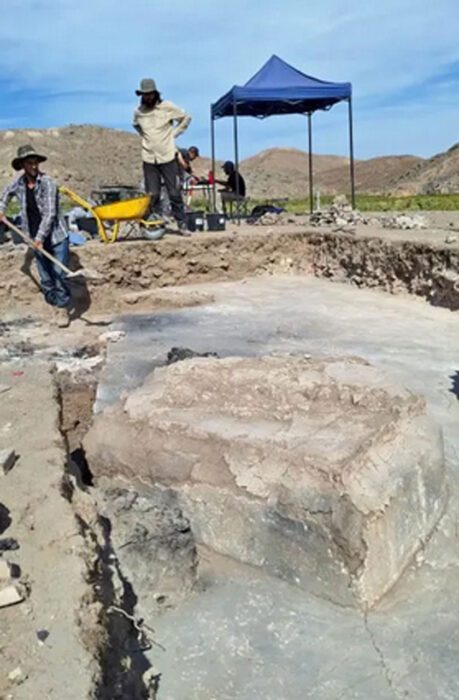TOURINFO-October 15, 2024-In a remarkable archaeological find, the remains of an ancient Armenian church dating back almost 2,000 years have been unearthed, making it one of the oldest structures of its kind not only in Armenia but in the world. The discovery was made by a joint team of archaeologists from Germany’s University of Münster and the Armenian Academy of Sciences during excavations in the ancient city of Artaxata. The University of Münster, which announced the find on Friday, hailed it as a “sensational testimony to early Christianity in Armenia.”

The unearthed structure is believed to have been built in the 4th century A.D., the same era that saw the construction of Etchmiadzin Cathedral, the oldest cathedral in Armenia and often regarded as the oldest cathedral in the world. This discovery offers new insights into the spread of Christianity in Armenia, the first nation in the world to adopt Christianity as its official state religion.
The Artaxata Excavations and Armenian Christianity
The excavation in Artaxata is part of the broader Armenian-German Artaxata Project, initiated in 2018 to explore and study the ancient city. Artaxata, once a thriving metropolis and commercial hub, served as the capital of the Armenian kingdom for several centuries before and after the common era. The city, located in the Ararat Plain near the medieval monastery of Khor Virap, holds significant historical and cultural importance. According to legend, it was here that Gregory the Illuminator converted the Armenian king Tiridates III to Christianity in 301 A.D., leading to Armenia becoming the first Christian state.

Achim Lichtenberger, a professor at the University of Münster and one of the key figures in the Artaxata project, described the church as “the oldest archaeologically documented church in the country.” He added that its discovery was “a sensational testimony to early Christianity in Armenia.”
The architectural design of the church adds another layer of intrigue to the discovery. Dr. Mkrtich Zardaryan of the Armenian Academy of Sciences explained that the church is the first octagonal-shaped Christian structure ever found in Armenia. This architectural style, with cruciform extensions, is more commonly found in the eastern Mediterranean and also dates back to the 4th century A.D.
The Octagonal Church: A Unique Architectural Marvel
Measuring approximately 100 feet (30 meters) in diameter, the church is octagonal in shape, with rectangular chambers extending from four sides. The building featured a simple mortar floor made from a mixture of sand and cement, while the walls were constructed from thick slabs of terracotta, a clay material widely used in Greece and Italy at the time. The church’s unique shape and layout resemble early Christian memorial buildings, which were often erected to commemorate important religious figures or events.
The discovery of terracotta tiles, alongside pieces of marble, suggests that the church was lavishly decorated, with some materials likely imported from the Mediterranean region. Wooden platforms uncovered in the church were radiocarbon-dated to the mid-4th century, further confirming the building’s ancient origins.

Dr. Zardaryan noted that the architecture of the octagonal church provides clues about Armenia’s interactions with other Christian centers in the early days of the religion. Octagonal churches, though rare in Armenia, were known to appear in the eastern Mediterranean during the 4th century, making this discovery an essential piece in understanding the development of Christian architecture in the region.
A Glimpse Into the Past
This extraordinary discovery sheds new light on the early spread of Christianity in Armenia, offering a tangible connection to the kingdom’s Christian history. Artaxata, once the capital of the Artaxiad and Arsacid dynasties, flourished as a major city in the Hellenistic period and remained a key center of commerce and culture for nearly six centuries.

The Armenian-German research team continues to excavate the site, hoping to uncover additional artifacts and information, including to whom the church was dedicated. Some speculate that the church may be linked to the conversion of King Tiridates III by Gregory the Illuminator, an event that played a crucial role in Armenia’s early Christian history. The proximity of the site to Khor Virap, a medieval monastery associated with the legend of Gregory’s imprisonment, adds further historical significance to the area.
Future Implications
The discovery of this ancient church is not only a landmark find in Armenian history but also an important contribution to the global understanding of early Christian architecture and religious practices. By revealing previously unknown details about Armenia’s Christian heritage, this discovery strengthens the historical narrative of the nation’s pivotal role in the early spread of Christianity.
As the excavation continues, archaeologists are hopeful that more secrets of the ancient Christian world in Armenia will be uncovered. The Armenian-German Artaxata Project has already revealed much about the city’s past, but this latest discovery has elevated the site’s importance as a crucial link in understanding the intersection of religion, culture, and architecture in the ancient world.
This church, once buried under centuries of history, now stands as a testament to Armenia’s rich religious heritage, offering a new chapter in the story of early Christianity.
TOURINFO-JUANITA MOURADIAN










